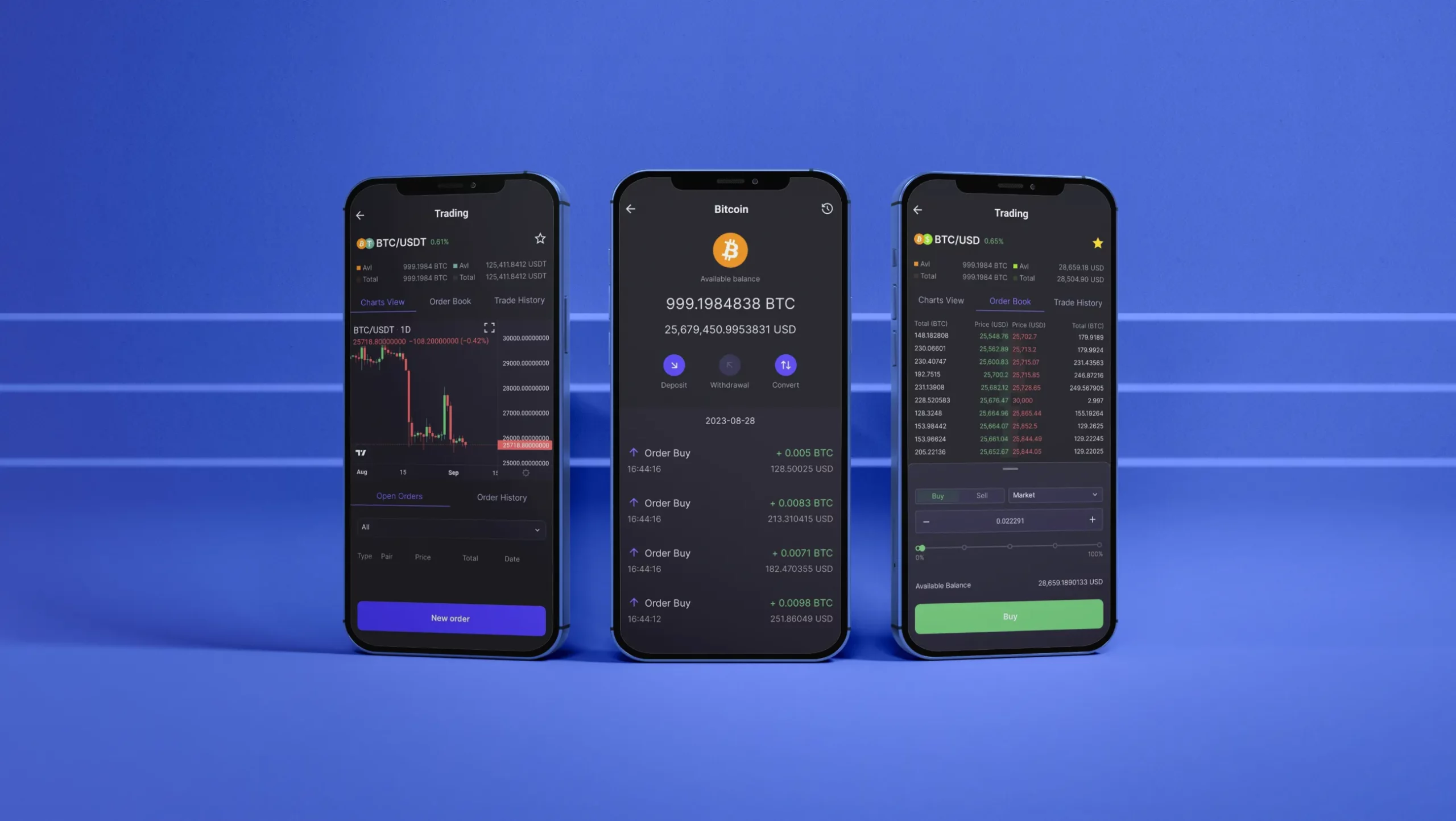- Crypto Solutions
- By business model
- By auction model
- Services
- Case studies
- Contact
Cryptocurrency exchanges have become the cornerstone of the digital economy, offering individuals and institutions a platform to buy, sell, and trade cryptocurrencies. In 2023, the world of crypto will be more dynamic than ever, with evolving market trends, increasing adoption, and regulatory changes shaping the landscape.
In this article, we’ll learn how much it costs to develop a cryptocurrency exchange in 2023. Also, we will explore the types of exchanges, like centralized cryptocurrency exchanges and decentralized exchange platforms, shed light on the factors that influence these costs, and get to know the necessary elements of crypto exchange platform development.
What Are Cryptocurrency Exchanges?
Cryptocurrency exchanges are online platforms that facilitate the trading of digital assets. In the crypto market, these platforms serve as intermediaries, which connect buyers and sellers. Whether you’re looking to convert your Bitcoin into Ethereum or engage in complex trading strategies, cryptocurrency exchanges provide the infrastructure to do so.

Types of Cryptocurrency Exchanges
Cryptocurrency exchanges come in various forms, each with its unique characteristics that cater to diverse user preferences. Understanding these exchange types is crucial when considering a cryptocurrency exchange software development company for your cutting-edge crypto exchange. Let’s revise the 2 most common types of crypto exchanges: centralized and decentralized.
Centralized Crypto Exchange (CEX)
CEXs function as traditional gateways into the world of digital assets. These platforms are mediators, facilitating cryptocurrency trading through a centralized authority, typically a company or organization. CEXs have gained popularity due to their user-friendly interfaces, high liquidity, and extensive trading features.
Features of CEXs:
- User-Friendly: Centralized exchanges are known for their intuitive interfaces, which makes them accessible even to beginners;
- Highly Liquid: CEX platforms often boast deep order books, ensuring that traders can execute orders quickly and at desired prices;
- Advanced: CEXs provide a wide range of trading tools: margin trading, stop-loss orders, and more, attracting both novice and professional traders;
- Centralized: Users trust to exchange their digital currency, which can pose risks if security measures are compromised;
- Regulated: CEXs need to adhere to regulatory requirements, which can limit access for users from certain jurisdictions.
Decentralized Crypto Exchange (DEX)
DEXs represent a departure from the traditional centralized model, introducing novel concepts that align with the foundational principles of blockchain technology.
Features of DEXs:
- Controlled: Users retain control of their funds throughout the trading process, reducing the risk of hacks or mismanagement;
- Private: DEXs often require minimal personal information, preserving user privacy;
- Resilient: Decentralized exchanges are less susceptible to single points of failure, which makes them more robust in the face of cyberattacks or downtime.
- Illiquid: Compared to CEXs, DEXs have lower liquidity, which can result in less favorable trading conditions;
- Complex: Using a DEX can be more technically challenging for newcomers;
- Limited: DEXs might not support as many cryptocurrencies and trading pairs as their centralized counterparts.
How Do Crypto Exchanges Make Money?
Before we dive into the cryptocurrency exchange development cost, it’s important to understand how cryptocurrency exchanges generate revenue. The lion’s share of profit comes from transaction fees. Every deposit, withdrawal, exchange is charged. Other popular income streams are listing fees, VIP services, market making. You can find a detailed guide on this topic in our article ‘How Do Crypto Exchanges Make Money?
Cryptocurrency Exchange Market – Overview
To understand the crypto exchange development cost in 2023, it’s crucial to grasp broader market dynamics. The crypto market is changeable and can be influenced by many aspects: market sentiment, regulatory changes, technological advancements, etc. To get detailed information about the current market trends, investigate reputable sources: CoinMarketCap, Forbes.
Cryptocurrency Exchange Development
Crypto exchange development is a multifaceted process that demands careful planning, meticulous execution and ongoing maintenance. To create a thriving exchange platform, you must:
- Plan. Begin by defining your exchange’s unique value, target audience and market positioning. Identify regulatory requirements and compliance measures based on your region;
- Develop. Build the backend infrastructure, a trading engine, an intuitive and visually appealing user interface (UI), order book system and security protocols to ensure seamless trading and robust user security;
- Test. Rigorous testing is essential to identify and rectify any vulnerabilities or bugs. Conduct thorough security audits to protect user assets;
- Launch. A well-planned launch involves marketing and promotion to attract the initial user base. Prepare regulatory compliance and support systems;
- Maintain. Continuous monitoring and maintenance are vital to address emerging issues. Update your system and ensure security remains robust.
Building a cryptocurrency exchange is a complex undertaking that demands careful consideration of these elements to create a secure, user-friendly, compliant platform. Each decision you make along the way will influence development costs, user experience and your exchange’s success.
How Much Does It Cost To Make a Cryptocurrency Exchange?
Creating a cryptocurrency exchange in 2023 involves navigating a dynamic landscape. Understanding the associated costs is essential for effective planning. The development approach you choose influences the expenses. Let’s break down the crypto exchange development costs based on different development approaches.
Developing from scratch
Creating a cryptocurrency exchange from the ground up offers maximum customization, allowing you to tailor every aspect to your unique requirements. However, this approach can also be the most expensive due to the extensive development requirements. The cost for building an exchange from scratch can range from $500,000 to $1 million or more, depending on the complexity and features.
Cost Considerations:
- Development Team: Hiring a skilled team of developers, blockchain experts and security professionals is a substantial investment. These experts are crucial for building a secure and feature-rich platform;
- Timeline: Developing from scratch often requires a longer timeline, which can result in higher labor costs and delayed time-to-market;
- Compliance: Regulatory compliance efforts can be resource-intensive, with legal and regulatory experts needed to ensure adherence to local and international regulations;
- Security: Building robust security features, such as cold storage, multi-signature wallets, continuous monitoring, adds to the crypto exchange development cost;
- Testing: Serious testing and security audits are a must, but also contribute to the overall expense;
- Maintenance: Ongoing support and maintenance are vital for user security and system reliability.
White label solution
The white label solution for a crypto exchange is a pre-built, fully functional cryptocurrency exchange platform that entrepreneurs and businesses can customize and brand as their own. The white label crypto exchange cost features software, technical support, licensing assistance and a bank account. Such package products range from $50,000 to $200,000. It is a cost-effective choice for startups and businesses looking to enter the market swiftly.
Cost Considerations:
- Licensing Fees: The white label cryptocurrency exchange cost includes licensing fees or revenue-sharing arrangements with the solution provider;
- Customization: White label solutions provide a foundation that you can customize to align with your branding and business objectives;
- Compliance: The white label product should be compliant with the regulatory requirements of your target market;
- Security Enhancements: Depending on the white label provider, you may need to invest in additional security measures.
On-Premise Model
Using a pre-built cryptocurrency exchange script represents a middle-ground option in terms of development time and customization. It is a frequent choice for mature businesses, since developing with a script means buying the source code. Costs for developing an exchange using a script can range from $100,000 to $300,000, depending on the script’s features and customization.
Cost Considerations:
- Script: The cost of acquiring a prepared cryptocurrency exchange script varies based on the script’s features and provider;
- Customization: While scripts offer a foundation, it is necessary to customize the script to meet your branding and functionality requirements;
- Development Team: With a script, you’ll still need a development team to work on customization, integration and ongoing maintenance;
- Regulatory Compliance: The script after customization should be compliant with relevant regulations;
- Security: Scripts contain basic security means. For additional advanced security components, you need to find security specialists;
- Testing and Maintenance: Scrupulous audits, ongoing support and maintenance are a critical expense item when developing with the script.

Cryptocurrency Exchange Development Cost Analysis
To create a cryptocurrency exchange, you need to include several critical components, each contributing to the overall cost of the project. Here’s a detailed cost analysis of key aspects:
Designing
The price for UI/UX design can vary widely. It depends on:
- The complexity of the design,
- The number of screens,
- The level of customization.
Typically, it can range from several thousand to tens of thousands of dollars.
Backend Support
The cost of crypto exchange backend development depends on:
- Scalability,
- Security,
- Technology stack.
A high-quality backend system can range from $50,000 to $200,000 or more.
Smart Contract Coding
For decentralized exchanges (DEXs), smart contract development is critical. The cost varies based on:
- The complexity of the contract,
- The number of functionalities,
- The existing blockchain.
Smart contract development can range from $10,000 to $50,000 and higher.
Adding Cryptocurrency
Integrating new cryptocurrencies involves technical work and regulatory compliance. Costs can vary based on the number of coins or tokens to be added, typically ranging from $5,000 to $15,000 per cryptocurrency.
Support & Maintenance
Ongoing support and maintenance are vital for exchange stability and security. Costs here are typically calculated as a percentage of the initial development cost, expanding from 15% to 25% annually. This includes:
- Server maintenance,
- Security updates,
- Technical support.
Factors that influence cryptocurrency exchange development cost
The cost of creating a cryptocurrency exchange in 2023 is subject to various factors, each playing a significant role in shaping the overall expenses. Here, we’ll explore the key factors that influence cryptocurrency exchange development costs:
Team
The size and expertise of your development team directly influence costs. A capable team with skilled developers, blockchain experts and security professionals is a substantial investment.
The geographic location of your team can also impact costs due to various labor expenses, regulatory compliance and tax implications in different countries.
Features
Cryptocurrency exchange software price is determined by the features you want to incorporate into your exchange. Instruments that increase expenses:
- Order book systems; ;
- Matching engine;
- Spot, futures, OTC trading markets;
- Cryptocurrency payment gateway integration;
- Mobile application development.
Carefully assessing the features your exchange requires is essential for cost management.
Complexity
The complexity of the cryptocurrency exchange software also affects the price. Whether you opt for a centralized exchange, decentralized exchange, the intricacy of the underlying infrastructure, consensus mechanisms and smart contract can impact expenses. Decentralized exchanges, for example, may necessitate more elaborate smart contract coding.
Time
Rushing the development process can lead to higher costs. Having a realistic timeline and project management strategy in place can help manage expenses more effectively.
Technologies
The choice of technology stack, blockchain platform and development tools can alter both development time and costs. The right tools and technologies can streamline the development process and reduce expenses.
IEO Module
If you intend to facilitate Initial Exchange Offerings (IEOs) on your platform, this module craves for additional development effort and regulatory compliance measures. Ensuring a compliant, secure IEO environment involves specific development costs related to:
- Token issuance,
- Smart contract development,
- Investor verification.
White Labeling
Offering white label solutions to other businesses can be a revenue stream, but it also involves development to cater to disparate client needs. Providing customization options, branding capabilities and robust infrastructure for white label clients entails extra development costs.

Components of Cryptocurrency Exchange
A successful crypto exchange platform is a complex ecosystem built upon various crucial components. Understanding these components is vital for potential operators. Whether you’re considering launching an exchange or looking to enhance an existing one, look through the foundational elements.
KYC Integration
The Know-Your-Customer mechanism stands as an indispensable component of any reputable cryptocurrency exchange. This feature ensures compliance with regulatory requirements by verifying identities on the platform. The functions of the KYC system:
- Uphold regulatory standards
- Safeguard against illicit activities,
- Protect user assets,
- Enhance the exchange’s credibility,
- Ensure its long-term sustainability.
AML Integration
The Anti-Money-Laundering system is designed to detect, prevent and report suspicious financial activities that may be indicative of money laundering or other illicit activities. The functions of the AML measures:
- Identify high-risk transactions,
- Monitor user behavior,
- Safeguard the integrity of the exchange,
- Reduce exposure to legal and financial risks,
- Foster trust among users.
The AML checks maintain a compliant, secure and transparent trading ecosystem, essential for the exchange’s legitimacy and long-term success.
Order Book System
An order book system is the heartbeat of any crypto exchange. It acts as a real-time ledger, meticulously recording and displaying all buy and sell orders for various cryptocurrencies, along with their corresponding prices and quantities. The functions of the order book:
- Provide a snapshot of market sentiment and liquidity,
- Update market changes,
- Reflect market changes instantaneously,
- Match buyers with sellers,
- Maintain a fair trading environment.
Admin Panel
The admin panel provides exchange operators and administrators with a centralized interface to manage and oversee critical aspects of the exchange’s operations. Within this control hub, administrators can:
- Monitor user accounts,
- Review transaction histories,
- Ensure compliance with regulatory requirements,
- Manage security protocols,
- Configure trading pairs,
- Address support tickets.
The admin panel empowers exchange operators to maintain the platform’s integrity, security and overall functionality.
Exchange Pairs
Exchange pairs dictate the trading possibilities and are essential for enabling users to diversify their portfolios. Exchange pairs can include popular cryptocurrencies like Bitcoin and Ethereum, altcoins, and even fiat currencies like USD or EUR. A wide range of exchange pairs fosters:
- Liquidity,
- Trading volume,
- Market activity.
Market Making
Market making involves the continuous provision of liquidity to trading pairs, ensuring there are always buyers and sellers available. Market makers use sophisticated algorithms and trading strategies to bridge the gap between supply and demand. The functions of market making:
- Stabilizing prices,
- Reducing spreads,
- Minimizing slippage.
This essential function attracts traders, maintains user confidence and contributes to the exchange’s success by facilitating smooth trading and promoting a dynamic trading environment.
Liquidity API
The liquidity API ensures that the platform maintains ample liquidity across various trading pairs, preventing order book imbalances and enhancing trade execution efficiency. By tapping into external liquidity pools and integrating market data, the liquidity API helps to:
- Minimize spreads,
- Reduce slippage,
- Bolster trading experience.
Margin Trading
Crypto margin trading empowers traders to amplify their potential returns and diversify strategies. This feature enables users to borrow funds, known as leverage, to trade assets beyond their available balance. The functions of margin trading:
- Attract experienced traders seeking greater flexibility,
- Engage risk-tolerant investors aiming to maximize their gains.
- Add depth to the exchange,
- Introduce alternative trading options.
Third-Party API
Third-party API integration connects your exchange with external services and expands its functionality. This component allows the exchange to incorporate a wide array of features:
- Data feeds,
- Charting tools,
- Payment gateways,
- And more.
By integrating third-party APIs, exchanges can access real-time market data, streamline trading processes and offer diversified services to users. This integration not only saves development time and resources but also keeps the exchange competitive and adaptable.
Payment Gateways
Payment gateways facilitate the seamless deposit and withdrawal of funds, allowing users to convert fiat currencies into cryptocurrencies and vice versa. The functions of payment gateways:
- Connect users to financial institutions,
- Foster liquidity,
- Promote the exchange’s growth.
Cross-Platform Compatibility
Cross-platform compatibility allows traders to access the exchange from desktop, smartphones, tablets, or any web-enabled device. By optimizing user interfaces and functionalities for different platforms, exchanges accommodate diverse user preferences and trading habits. The functions of cross-platform compatibility:
- Broaden the exchange’s user base,
- Enhance user retention and satisfaction.
Crypto Wallet
A cryptocurrency wallet platform serves as a secure repository allowing users to store, manage and access cryptocurrencies. The functions of wallets:
- Safeguard user funds,
- Implement withdrawal and deposit transactions,
- Enable seamless trading on the exchange.
Why Choose Merkeleon for Crypto Exchange Development?
Experienced. Merkeleon is committed to providing the expertise and solutions needed to thrive in the world of crypto technologies. Our team of cryptocurrency exchange developers, blockchain specialists and security professionals is well-equipped to handle the intricacies of crypto exchange development.
Advanced. Merkeleon offers a comprehensive suite of features essential to build a successful cryptocurrency exchange. From order book systems and KYC/AML integration to cryptocurrency payment gateways and mobile applications, our solutions are designed for the demanding crypto community.
Regulated. Navigating the ever-evolving regulatory landscape is a top priority in the crypto industry. Merkeleon is well-versed in compliance requirements and ensures that your exchange meets the necessary regulatory standards.
Flexible. We understand that each crypto exchange has unique requirements. Merkeleon’s solutions are highly customizable, inspiring you to tailor your exchange to specific market niches and user preferences. Whether you need a whitelabel solution or a fully bespoke exchange, we have you covered.
Supportive. Launching your crypto exchange is just the beginning. Merkeleon provides ongoing support and maintenance services to keep your platform secure, up-to-date and responsive to user needs. Our commitment to your success extends well beyond the initial development phase.
Proven. Merkeleon has a proven track record of delivering successful crypto exchange projects for clients worldwide. Our portfolio includes a diverse range of exchanges, each tailored to the unique goals of our partners.
Affordable. We offer competitive pricing options to ensure that your crypto exchange project remains cost-effective without compromising on quality or security. Our transparent pricing models help you make informed decisions and stay within your budget.
Check out ‘How To Start Your Own Crypto Exchange Business In 8 Steps.’ Stay tuned for more insights and guidance on cryptocurrency exchange development from Merkeleon as we continue to explore crypto assets and blockchain technology.







